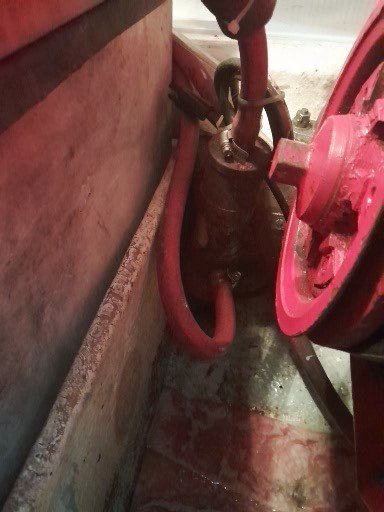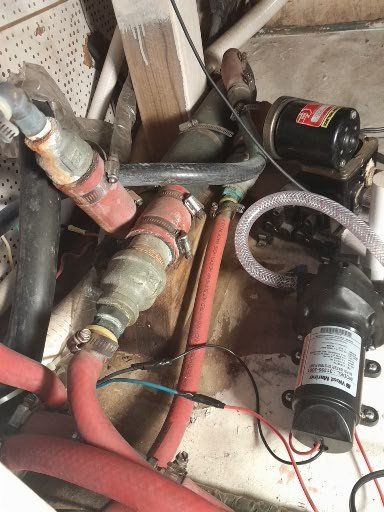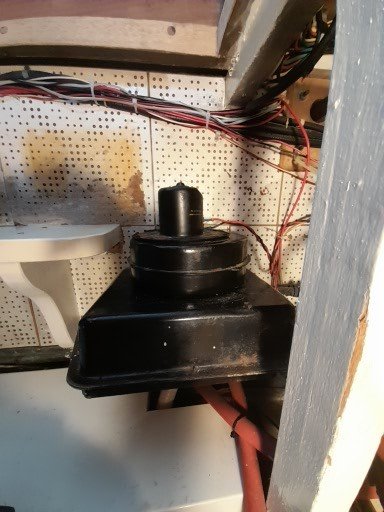I bought a 77 CHB about a year ago. I'm installing a forced air heating system. It presently has installed, a water heater, and a Red Dot heater that doesn't work. If my understanding is correct the only difference between a marine water heater and one in your home is that engine heat can be circulated through the water heater instead of 120v when the boat is sailing. In other words a hose comes off the outlet port on the engine to the heater, and returns through a hose to the inlet side. On my boat the coolant coming off the engine goes first to a cylinder attached to a bulkhead just off the engine (photo). It then goes through at least two other cylinders, one at least 24" long...and one comes off that to one that is vertical. It then goes through the Red Dot heater and on to the hot water heater. I'm baffled by what these inline cylinders do?? What I would like to do is route the engine coolant directly in and out of the water heater and eliminate the Red Dot heater and all these inline obstacles. I am reluctant to do so until I know what I'm removing. Does anyone know what these are? Certainly they are there for some reason, but what. Its hard to see what I'm talking about in the pictures, but you can see in the pictures there are some pretty substantial galvanized fittings on these things.
You are using an out of date browser. It may not display this or other websites correctly.
You should upgrade or use an alternative browser.
You should upgrade or use an alternative browser.
1977 CHB Trawler
- Thread starter dartagnan
- Start date
The friendliest place on the web for anyone who enjoys boating.
If you have answers, please help by responding to the unanswered posts.
If you have answers, please help by responding to the unanswered posts.
Pete Meisinger
Guru
- Joined
- Oct 7, 2012
- Messages
- 3,145
- Location
- USA
- Vessel Name
- Best Alternative
- Vessel Make
- 36 Albin Aft Cabin
The first two pictures seem to be heaters for the engine. I think you will find that there are 110 volt plugs on them. They are commonly used on automobiles in the North to keep some heat in the engines so they will start more easily when it is -30. You rarely see them anymore now that most cars are fuel injected and are better designed for cold weather starts.
The black contraption in the bottom picture is a "bus heater". I think you will find it is attached to a cabin wall with a grid cut out in the living area, although it looks like it might be designed to raise the temp of the engine room, why I could not guess. However the two red hoses would be a good source of engine heat the route through your water heater.
As an "aside". I have a five gallon household 110 Volt water heater in my bilge. It holds five gallons of water very warm for 5 or 6 hours during a cruise. When I fire up the genny or plug in at a marina the water is hot almost instantly, certainly taking less than five minutes. The heater is about eight years old and should last at least five more years. Cost was around a hundred dollars compared to a thousand or more for a engine heat capturing model.
pete
The black contraption in the bottom picture is a "bus heater". I think you will find it is attached to a cabin wall with a grid cut out in the living area, although it looks like it might be designed to raise the temp of the engine room, why I could not guess. However the two red hoses would be a good source of engine heat the route through your water heater.
As an "aside". I have a five gallon household 110 Volt water heater in my bilge. It holds five gallons of water very warm for 5 or 6 hours during a cruise. When I fire up the genny or plug in at a marina the water is hot almost instantly, certainly taking less than five minutes. The heater is about eight years old and should last at least five more years. Cost was around a hundred dollars compared to a thousand or more for a engine heat capturing model.
pete
socalrider
Guru
- Joined
- Feb 14, 2020
- Messages
- 1,012
- Location
- usa
- Vessel Name
- SEA WOLF
- Vessel Make
- 1979 CHB 41 Trawler
As an "aside". I have a five gallon household 110 Volt water heater in my bilge. It holds five gallons of water very warm for 5 or 6 hours during a cruise. When I fire up the genny or plug in at a marina the water is hot almost instantly, certainly taking less than five minutes. The heater is about eight years old and should last at least five more years. Cost was around a hundred dollars compared to a thousand or more for a engine heat capturing model.
pete
I'd probably go that route if I were to replace my water heater. When the engine is running electricity is plentiful, so no big advantage to capturing a bit of waste engine heat. I have a DC boat (no gen or inverter) & have modified my heater to use DC as well.
Thanks for the replies. Engine heaters huh? Well that makes sense considering this boat was originally in Alaska. I'll look for plugs the next time I'm on the boat. I wonder why so many? And they appear to be connected in series. Do you feel as I do that the whole mess can be removed and route new hoses round trip to the water heater??
Pete Meisinger
Guru
- Joined
- Oct 7, 2012
- Messages
- 3,145
- Location
- USA
- Vessel Name
- Best Alternative
- Vessel Make
- 36 Albin Aft Cabin
Yep, you can get rid of every bit of it.
I'm guessing it was a commercial vessel and "time was money" they had to go out every day no matter what the weather. An engine which would not start due to the cold was like no engine at all.
pete
I'm guessing it was a commercial vessel and "time was money" they had to go out every day no matter what the weather. An engine which would not start due to the cold was like no engine at all.
pete
Comodave
Moderator Emeritus
- Joined
- Jul 2, 2015
- Messages
- 21,288
- Location
- Au Gres, MI
- Vessel Name
- Black Dog
- Vessel Make
- Formula 41PC
I would put shutoff valves at the engine on the water heater hoses so that if a hose or the heat exchanger leaks you can shutoff the coolant to the water heater and still keep running.
Similar threads
- Replies
- 4
- Views
- 495



